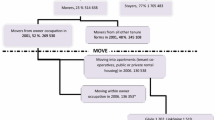Abstract
Few social-psychological theories of intraurban residential mobility have been offered, despite a number of empirical studies of personal motives. A complete explanation of residential mobility would interrelate macroscopic economic factors with household preferences. A cross-cultural socio-psychological model is presented as a step toward a comprehensive theory. Data from an exploratory study of middle-class Mexico City residents are used to test the model. Results suggest that middle-class Mexicans decide to move because of space needs accompanying life-cycle changes, desire for home ownership, and environmental reasons. Home selection was primarily a function of availability, cost, and terms. Unlike North Americans, suburban Mexicans were uninterested in community activities and maintained close contact with relatives; central-city respondents enjoyed living in the city despite dissatisfaction with residence or neighborhood. Most would avoid the suburbs because of communication problems and distance from relatives. Results support the model and justify further testing and development.
Similar content being viewed by others
References
Abrahamson, M., and Johnson, P. (1974). The social ecology of Madrid: Stratification in comparative perspective.Demography 2 (August): 521–532.
Amato, P.W. (1968). An analysis of the changing patterns of elite residential areas in Bogota, Colombia. Unpublished PhD dissertation, Cornell University.
Bataillon, C. (1964). La geografia urbana de la Ciudad de Mexico.America Latina 7 (October–December): 71–87.
Bataillon, C., and Rivere D'Arc, H. (1973).La Ciudad de Mexico. Sep/Setentas, Mexico City.
Berry, B. J. T. (1973).The Human Consequences of Urbanization. St. Martins Press, New York.
Beshers, J. M. (1962)Urban Social Structure. Free Press, New York.
Burukhov, E., Ginsberg, Y., and Werczberger, E. (1979). The social ecology of Tel-Aviv: A study in factor analysis.Urban Affairs Quarterly 15(December): 183–205.
Butler, E. W., Chapin Jr., F. S., Hemmens, G. C., Kaiser, E. J., Stegman, M. A., and Weiss, S. F. (1969).Moving Behaviors and Residential Choice. National Cooperative Highway Research Program Report 81. National Academy of Sciences, Highway Research Board, Washington, D.C.
Butler, E. W., and Kaiser, E. J. (1971). Prediction of residential movement and spatial location.Urban Affairs Quarterly 6(June): 477–494.
Carter, H. (1972).The Study of Urban Geography. Edward Arnold, London.
Chevan, A. (1968).Moving in a metropolitan area. Unpublished PhD dissertation, University of Pennsylvania.
Clark, W. A. V., and Cadwallader, M. (1973). Locational stress and residential mobility.Environment and Behavior 5(March): 29–41.
Coleman, J. (1975). Social structure and a theory of action. In Blau, P. (ed.),Approaches to the Study of Social Structure, Free Press, New York.
Cornelius, W. A. (1975).The Impact of Cityward Migration on Urban Land and Housing Markets: Problems and Policy Alternatives in Mexico City. Center for International Studies, Massachusetts Institue of Technology, Cambridge, Mass.
Diamond, D. B. (1979). Income and residential location: Muth revisited.Urban Studies 17(February): 1–12.
Dotson, F., and Dotson, L. O. (1957). La estructura ecologica de las Ciudades Mexicanas.Revista Mexicana de Sociologia 19(Jan.–April): 39–66.
Duncan, O. D., and Schnore, L. F. (1959). Cultural, behavioral and ecological perspectives in the study of social organization.American Journal of Sociology 65(September): 132–146.
Firey, W. (1949).Land Values in Central Boston. Harvard Univ. Press, Cambridge.
Fischer, C. S. (1976).The Urban Experience. Harcourt, Brace, Jovanovich, New York.
Fredland, D. R. (1974).Residential Mobility and Home Purchase. D.C. Heath, Lexington, Mass.
Gist, N., and Fava, S. F. (1974).Urban Society, 6th Ed. Crowell, New York.
Hall, P. (1977).The World Cities, 2nd Ed. McGraw-Hill, New York.
Hansen, R. D. (1971).Mexican Economic Development: The Roots of Rapid Growth. National Planning Association, Washington, D.C.
Harris, L., and Associates (1978).A Survey of Citizen Views and Concerns about Urban Life: Final Report. Washington, D.C.
Hayner, N. S. (1968). Mexico City: Its growth and configuration 1935–1960. In Fava, S. F. (ed.),Urbanism in World Perspective, Crowell, New York.
Herbert, D. (1973).Urban Geography: A Social Perspective. Praeger, New York.
Hoyt, H. (1968). Recent distortions of the classical models of urban structure. In Fava, S. F. (ed.),Urbanism in World Perspective, Crowell,New York.
Kain, J. F. (1975).Essays on Urban Social Structure. Ballinger, Cambridge, Mass.
Kasarda, J. (1972). The theory of ecological expansion.Social Forces 51(December): 165–175.
Kasarda, J. (1976). The changing structure of metropolitan America. InThe Changing Face of the Suburbs, Schwartz, B. (ed.), Univ. of Chicago Press, Chicago.
Lansing, J. B., and Hendricks, G. (1976). Living patterns and attitudes in the Detroit region. InThe Changing Face of the Suburbs, Schwartz, B. (ed.), Univ. of Chicago Press, Chicago.
Leslie, G. R., and Richardson, A. H. (1961). Life cycle, career patterns and the decision to move.American Sociological Review 26: 894–902.
Marans, R. W., and Rodgers, W. (1975). Toward an understanding of community satisfaction. In Hawley, A., and Roch, V. (eds.),Metropolitan America in Contemporary Perspective, Halstead Press, New York.
Moriarty, B. M. (1974). Socioeconomic status and residential locational choice.Environment and Behavior 6(December): 448–469.
Rossi, P. (1955).Why Families Move. Free Press, Glencoe, Ill.
Schnore, L. F. (1957). The growth of metropolitan suburbs.American Sociological Review 22(April): 165–173.
Schnore, L. F. (1965). On the spatial structure of cities in the two Americas. In Hauser, P. H., and Schnore, L. F. (eds.),The Study of Urbanization, Wiley, New York.
Schwirian, K., and Rico-Velasco, J. (1971). The residential distribution of status groups in Puerto Rico's metropolitan areas.Demography 8(February): 81–90.
Thomlinson, R. (1969).Urban Social Structure. Random House, New York.
Unikel, L. (1972).La Dinamica del Crecimiento de la Ciudad de Mexico. Fundacion Para Estudios de la Poblacion, A.C., Mexico City.
Willhelm, S. M. (1964). The concept of the ‘ecological complex’: A critique.American Journal of Economics and Sociology 23(July): 241–248.
Yujnovsky, O. (1975). Urban spatial structure in Latin America. In Hardoy, J. E. (ed.),Urbanization in Latin America, Doubleday, New York.
Author information
Authors and Affiliations
Additional information
I am grateful to the University of Alabama Research Grants Committee and Center for International Studies for financial support to carry out this study.
Rights and permissions
About this article
Cite this article
Coombs, D.W. Middle-class residential mobility in Mexico City: Toward a cross-cultural theory. Hum Ecol 9, 221–240 (1981). https://doi.org/10.1007/BF00889134
Issue Date:
DOI: https://doi.org/10.1007/BF00889134




